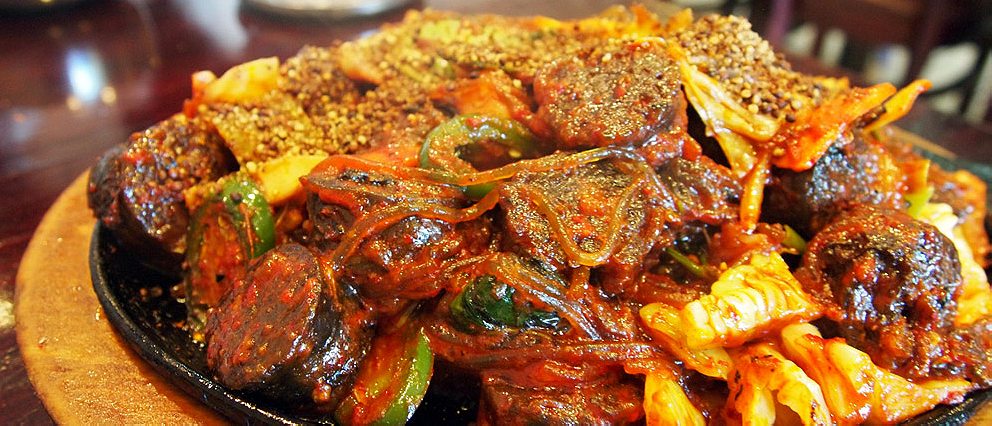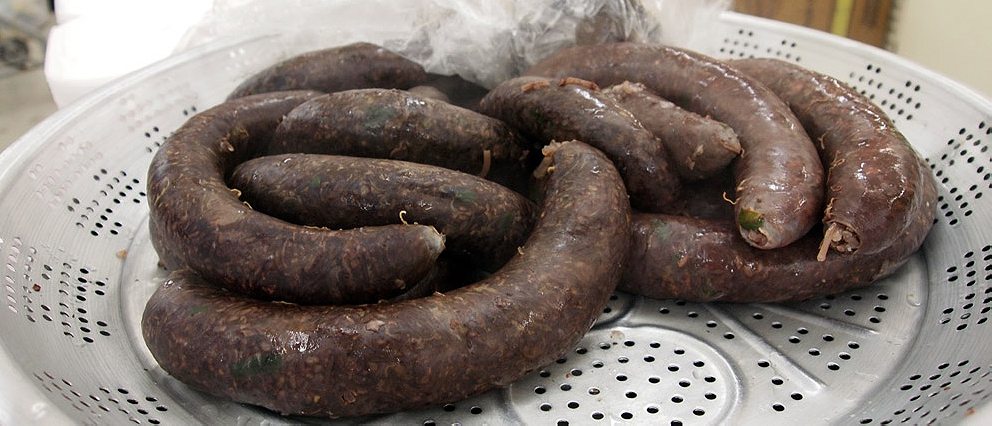On the hunt for Korean blood sausage in the unlikeliest of places: northern Virginia.
Sizzling on the griddle. Glistening on the smoker. Crackling on the charcoal grill. Plump and moist on the steamer. Off it comes, fat and juices ready to burst out of the casing. The snap of the first bite, a convulsion of fluids, steam evaporating from your mouth. Climactic. A perfect balance of salt and sweet and fat. The warmth. It’s home.
One hardly pictures the Korean Peninsula when thinking about sausages. Yet blood sausage is engraved in Korea’s gastronomic culture and history. Throughout centuries of foreign invasions and occupancy, “sundae” has become the people’s food of Korea. Historically, sundae was a luxury, devoured mostly during cultural festivities and large familial gatherings. Ground meats and vegetables of all kinds were stuffed into cow and pig intestines. Then the war happened, followed by twenty years of hunger. People ate tree bark and grit-filled oatmeal to survive; Sundae was re-born as a famine food. Cellophane noodles—dangmyeon—replaced pricier meat fillings, and sundae became a popular street fare in the open-air markets in all corners of the Peninsula. And no part of the animal went to waste: organs of all kind were boiled and eaten, always the sidekick alongside the sundae blood sausage. A Batman and Robin sort of thing.
As waves of Korean immigrants crashed into each coast of this continent, sundae also took root in the oddest of places: Northern Virginia. The Washington-metro area has the third-largest Korean population in the U.S., behind Los Angeles and New York—some 40,000 plus in Fairfax County alone. The first immigrants arrived in the 1950s, after fleeing a war-stricken Korea. The food also traveled along, like a suitcase of family photos, and nestled in towns like Annandale, Fairfax, Falls Church. Compared to the Korean barbeque joints—which are great but barely even hint at the depth and breadth of Korean meats—sundae shops are still a rare commodity here. Tragic, but we’ll live.
When I picture sundae, I think of Grandpa coming home with a black plastic bag. The rigid cold winter air, smoke billowing from the chimney tops. Out from the black bag comes steaming sundae, fresh from the sundae lady down the street. Some salt, a bit of kimchi, and you had a meal—that is my childhood in a nutshell. Born and raised in Hwanghae province of North Korea, Grandpa fled when the Korean War broke out, leaving behind his family, his home, his life, permanently separated, detached by force of barbed wire and machine guns. To Grandpa, sundae was home, a painful yet warm reminiscence of what life once was, before the bloodshed, before the bitterness.
So I craned my neck in search of sundae that Grandpa would be proud of, the perfect intermingling of pig intestine, dangmyeon, and blood. Here now, the top sundaes of Northern Virginia:

Round One: The Powerhouse
You run into one of many Koreans in Annandale and ask where you can indulge in a steaming plate of sundae, and nine out of ten will tell you, “of course, Seoul Soondae” (another spelling, same dish). You wonder if LA food truck heroes “Seoul Sausage” are related, but no. Seoul Soondae is a Virginia blood sausage powerhouse, the only place that boasts of specializing in the full spectrum of sundae dishes. On rainy days, friends of all ages gather over platters of sundae and boiling pots of potato stew. A few rounds of soju, the slurping of broth, the sucking of meat off the bone—dining at its finest.
South Koreans enjoy sundae in three ways. 1) Steamed, with sides of steamed liver, lungs, stomach and other organ meat. 2) Boiled as a soup, with miso, cabbage, and yes, more organ meat. 3) Stir-fried with dangmyeon, onions, garlic, sesame leaves and cabbage, spiked with a chili paste so spicy it should have its own name. Like a good Korean, I order all three varieties.
For the same reason that I’d take sashimi over nigiri sushi any day, I’m a fan of sundae in its purest form: steamed. Just a dash of salt, maybe a little kimchi or pickled radish on the side. The best sundae shouldn’t be dry, too irony, or too porky. The metallic tang of the blood should almost have a sweet aftertaste. The casing should be chewy, not rubbery. It’s about the intermingling of texture and moisture: firm but not dry, rich and nutty. Seoul Sundae did not have any veggies in its filling, and the dangmyeon was almost bare naked, cloaked only by blood. The sundae lay there, dry and helpless, like leftover meatloaf. It lacked the brooding spice and gentle metallic tang of fresh blood so vital to true sundae.
Next up: the second style, which is blood sausage smothered in a red-hot chili-based sauce, sizzling and smoking on a heated iron platter. It’s like the best sex: pungent and loud, with a sizzle that demands your full attention. I work my chopsticks through the mound of crimson chunks. Sesame leaves and ground perilla seeds add a deep herbal note. Spicy as hell, but sweet and savory, the heat slowly building in your abdomen, rising to the back of your throat. The sundae is moist, and the cabbage is soaked in spicy, perilla-flavored grease. Cabbage that tastes better than meat.
The final presentation is a hot bowl of broth with sausage and organ meat—I’d wake up to this every day. Splash in some hot chili paste, add some rice, and nothing soothes the stomach more. Korean miso—dwenjang—is the ultimate comfort food, wonderfully complementing the sundae. Compared to its Japanese cousin, dwenjang is heartier and earthier. You can see and feel the barley and the fermented beans. This texture is palatable, even pleasant, and the extra barley and beans lend a deeper flavor that marries perfectly with the funk of organ meat. Lung, liver, stomach: true sundae aficionados are more thrilled about the organs on the side than the sausage itself. All you need is a side of radish kimchi and this pulsating bowl is enough to convert even the staunchest doubters.

Round Two: The Supermarket Surprise
On a not-so-important Sunday afternoon, rain is pouring, and I already had pho the day before. I need steaming broth, preferably with sour kimchi and fresh pork belly. My doctor might cringe, but it’s the only cure for the endemic madness of being a lawyer by day. I haul myself to H-Mart.
I push my cart through rows of instant ramen and fresh seafood and load a cart with more foodstuff than my credit card can digest—kimchi, pork, tiny pastries, the works. To my surprise, I spot sundae, tucked away in the darkest of corners, seemingly fresh, still steaming in the package. Sizzling platters or boiling soups are nowhere to be found, but an order of sundae is like a cherry on top of my cart.
Not a bit of dryness or staleness; this must be made in-house. Just enough tang from the blood, a firm casing tightly hugging the moist dangmyeon, and that nutty aftertaste on your tongue. Compared to the conglomerate Seoul Sundae, H-Mart also added glutinous rice, giving it extra texture and moisture. A light dip into the seasoned salt, and the sausage melted away on the tip of my tongue.
Round Three: The Hidden Gem
There are a dozen varieties of sundae. Each region of the Peninsula has its own unique story behind the birthing of this delicacy. In the north, the famous “abai” sundae, with more vegetables and variety in their fillings. In the east, the “squid” sundae, a whole squid stuffed with minced pork and a laundry list of vegetation (this variety is a must-try, but nowhere to be found within a thousand-mile radius of my town). Then there is the “baek ahm” sundae of Kyung-gi province (bean sprouts and tofu added), “byung-chun” sundae of Choong-chung province (veggies, veggies, veggies), and “Kaesung” sundae from the city of Kaesung (ground pork and noodles). And yes, even Jeju Island has its own variety (say hello to barley, buckwheat, and chives).

Alas, none of the regional sundae above is available around here, maybe the entire continent. The sundae here is simple, with dangmyeon and blood, some with glutinous rice. The search for the sundae of Grandpa’s era was hopeless, as it seemed that other varieties were on the verge of extinction.
But then, tucked away in Fairfax, VA, in the most unlikely of places, I stumbled across something beautiful: “Pyongyang Sundae”. Not in a restaurant. Not in a mega-supermarket. But on a few tables inside Lotte Mart. The glistening coils of fresh sundae were resting peacefully on the steamer—just as I remember from the street markets in Korea. The sundae is wrapped in clear plastic, which puffs up with the pungent steam from the sausage. Liver and stomach rest side by side in perfect harmony. A young lady goes to work, uncoiling a generous handful of sundae and organs onto her cutting board. The methodical thud of the knife hitting the board, slicing through the snappy casing and soft insides, and my mind already wanders the open market—fish mongers yelling, scooters honking, and that thwack of knife on cutting board. That steam, as if the sundae just stepped out of a spa treatment.
The Pyongyang Sundae had more glutinous rice and cabbage. The metallic tang I’ve yearned for, it was there. The nutty, even buttery blend of spices, it was there. Homemade to the core, maybe even earlier that day. Most importantly, the sausage is cooked just right. No dry pockets, just pure warmth.
Here, you won’t find spicy sauces or miso soups. Here, the sundae is all you’ll get, all you’ll need. Nothing fancy or showy. Just fresh ingredients, put together with love in methods dating back decades and centuries. Food that is a slingshot of memories, a panorama of childhood films. This is it.